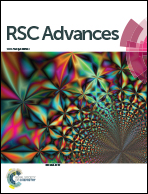Reusable Fe3O4 and WO3 immobilized onto montmorillonite as a photo-reactive antimicrobial agent†
Abstract
Active near-infrared (NIR) tungsten oxide (WO3) and iron oxide (Fe3O4) were immobilized in exfoliated montmorillonite (MMT) by the intercalation of 2-chloro-3′,4′-dihydroxyacetophenone and 1,3-propanesultone quaternized poly(dimethyl amino)ethyl methacrylate (C/S-PDMA) via ionic exchange reaction. UV-Vis spectroscopy, Fourier transform infrared spectroscopy, X-ray diffraction, field-emission scanning electron microscopy and energy-dispersive X-ray spectroscopy were used to confirm the construction of nanocomposites of an enlarged MMT layer with WO3 and Fe3O4 by C/S-PDMA based on catechol chemistry. The metal oxides-immobilized MMT showed the colloidal stability and photothermal effect required for NIR mediated nanocomposites. The NIR mediated nanocomposites showed a high efficiency photothermal effect within 2 min towards both Gram positive (S. aureus) and Gram negative (E. coli) bacteria. Study of the recycled exfoliated MMT by the WO3 and Fe3O4 complexed polymer study disclosed rapid and effective killing for both strains of bacteria within 4 min of NIR irradiation, in which almost 100% of both strains of bacteria were destroyed even after three cycles. This approach is promising for effective, rapid, and stable antibacterial photothermolysis agents.


 Please wait while we load your content...
Please wait while we load your content...